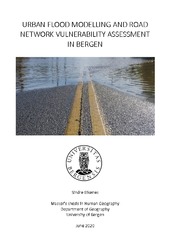| dc.description.abstract | Increased emissions of greenhouse gases have brought the world’s climate into a process of change. The oceans and atmosphere are warming up, which also initiates other negative consequences such as more severe urban floods. This thesis investigates the impacts and vulnerabilities that the city of Bergen, located on the rain-intensive western coast of Norway, experienced after a flood event that occurred the 14th. September 2019, and additionally how such an event would take form in the year of 2100 by adding a linear increase of 30% to the precipitation estimates. Furthermore, an assessment is performed to evaluate the vulnerability of the road network in Bergen from the GIS-modelled scenarios of urban flood. Throughout the analysis, the following questions are being answered: How well can a major flood event be replicated using hydrological modelling based on high-resolution LIDAR data? What are the potential impacts of a flood based on end of century precipitation estimates? Which parts of the Bergen road network are most vulnerable to flooding; and what are the implications for the whole road network? The results show that vital infrastructure such as buildings and roads are indeed vulnerable to flood since they receive a large share of the total amount of water within the catchment area. However, while one would expect an increase of flood in these same areas by the end of the century, the results show that this is actually not occurring. This suggests that the excess water has found other, less vulnerable places to accumulate in 2100 since the depressions located in and around the infrastructures are already more or less fully inundated. The level of mobility for motorists in the neighborhoods of Møhlenpris and Sydnes are found to be very reduced since most of the roads leading in and out are blocked by floods. Last but not least, it is proved that the highly trafficked and vulnerable area of Bryggen which is on the UNESCO list (United Nations Educational, Scientific and Cultural Organization) for World Cultural Heritage is also susceptible to large amounts of surface flood. Urban flood modelling is important in order to assess the economic and socio-economic impacts that the society may face. One major limitation to the analysis is that the drainage system and rate of infiltration is modelled by using a dataset of uniform values representing the losses of water instead of applying a dynamic coupling between a surface flood model and drainage model. | en_US |
